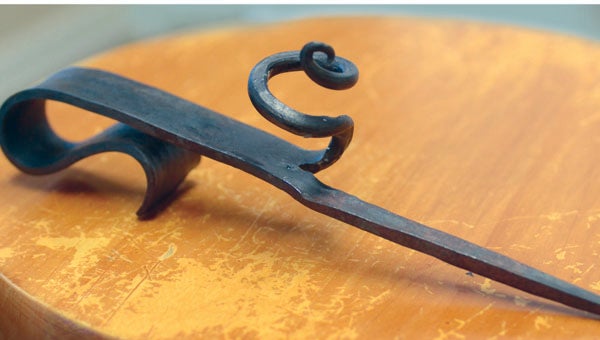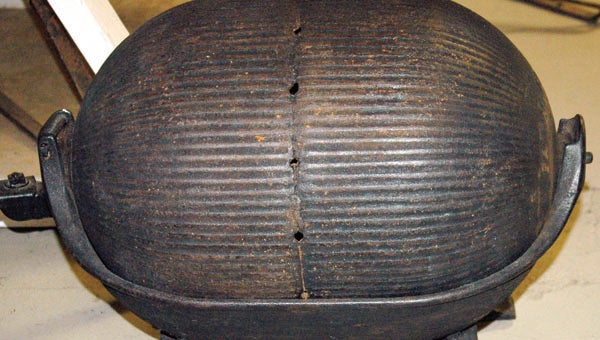HIstory at ODDS: Intriguing artifacts abound at Pioneer Museum
Published 3:00 am Saturday, January 16, 2016

The Pioneer Museum of Alabama has more than 25,000 artifacts but there are still artifacts that the museum doesn’t have but would greatly appreciate. Visitors to the museum have fun trying to identify many of the odd items. This item has not been identified and the first person to correctly ID the item will get free admission to the museum. Call 566-3597 to wager a guess.
Back in the mid-1990s, the Pioneer Museum of Alabama could boast of more than 18,000 artifacts. Today, that number has climbed to 25,000-plus.
Although that might seem like a large number of artifacts primarily from the 1800s, Kari Barley, museum director, said that’s not nearly all the items from that period of Alabama history.
“The Pioneer Museum of Alabama has artifacts that date back to the mid-1700s and as recent at the early 1900s, “Barley said. “But the concentration of our artifacts is the 1800s and we do have a good collection.”
Visitors to the museum often ask, “Is there anything you don’t have?”
And Barley always answers, “a lot.”
“There is no way to know how many artifacts there are from that period of time,” she said. “Crafters, tradesmen and homemakers created items to make their workloads easier, children made their own toys and musicians made their own instruments. At the museum, we are always looking for artifacts that were made from necessity or just for individual pleasure.”
To visit the Pioneer Museum of Alabama is to step back in time and to a very different way of life.
Barley said, for some visitors to the museum, the journey is a memory walk.
“People remember things from their childhood or recognize items that they have heard about or read about,” she said. “People are always excited when they recognize items and are thankful for the memories they bring back.
“A lot of times, visitors to the museum will ask about certain artifacts. The one artifact that people are most curious about is the hog oiler. It’s strange looking and there’s not anything about it that would give you a clue to what it is.
The hog oiler is round; it’s black; it’s metal with holes in the middle and ridges around the holes; and that’s about all there is to it.
“Hogs like to rub and scratch,” Barley said. “Back when people raised hogs, they would pour their leftover grease in the hog oiler and the hog would rub up against it and the oil would come out and get on the hog’s skin. The oil would help keep the hog from itching and it would also keep the bugs off.”
Barley said the weasel is another artifact that generates a lot of interest.
“The weasel is a way that women used to measure their yarn,” she said. “Before the weasel was invented they measured a yard of yard from the tip of the nose to the tip of their fingers. Of course, that was not very accurate. When the weasel as invented, women had a way to measure a yard of yarn more accurately.”
Barley said the weasel could be set to measure a certain length of yarn. When it got to that length, the weasel would ‘pop.’ And, that’s where we get the song, ‘Pop! Goes the Weasel.’”
The rocking churn was created, perhaps, to take some of the workload of the woman of the house.
“A woman could sit in a rocking and rock and turn the churn at the same time,” Barley said.
Another item of interest is the stereoscope that was designed about 1840 by Oliver Wendell Holmes.
“The stereoscope provided our first 3D images,” said Seth Kinard, museum assistant director. “The images were taken with a camera that was actually two-cameras in one. You got two pictures of the same image. The stereoscope was a popular why to view pictures.”
Kinard said the bed warmer was a welcomed invention.
“The bed warmer was a covered pan on the end of a long stick,” he said. “People put hot coals from the fireplace or wood from the stove in the pan and then slipped the pan under the bedcovers and moved it around the bed until the entire bed was warmed and they would get in.”
A mustache cup attracts a lot of interest from museum visitors.
“The mustache cup was an ornate cup used by men with mustaches,” Kinard said. “It had a ‘lip’ inside the cup that kept the coffee or what the drink was, from getting on the man’s mustache and causing embarrassment at a social event.”
Kinard said some ask about the dainty pink mustache cup.
“All I can think of is that the cups were part of a set,” Kinard said. “They weren’t individual cups like mugs today.”
Barley and Kinard said they have learned a lot about Alabama pioneers and their way of life from the many artifacts at the museum.
“I don’t care how many times I look at the displays, I always see something I haven’t noticed before and I learn something that gives me a deeper appreciation of the Alabama pioneers,” Barley said.
The Pioneer Museum of Alabama is open from 9 a.m. until 5 p.m. Tuesday through Saturday. Admission is $6 for adults, $5 for seniors and $4 for students.





